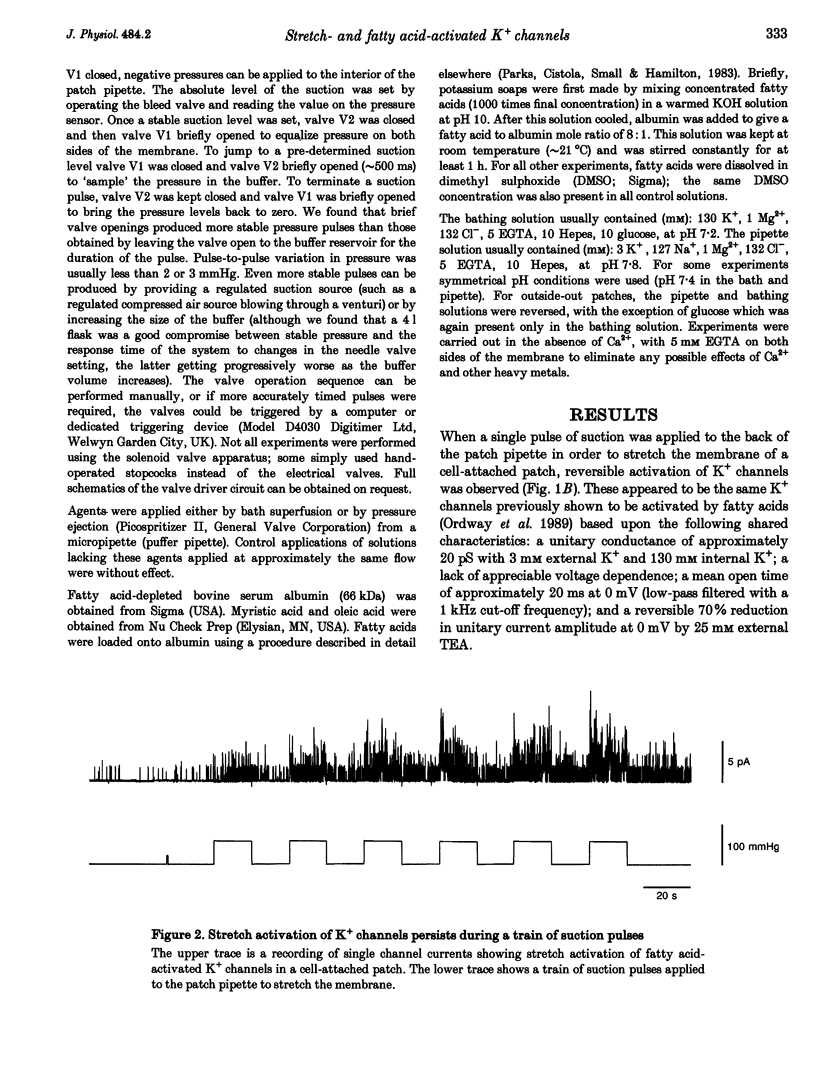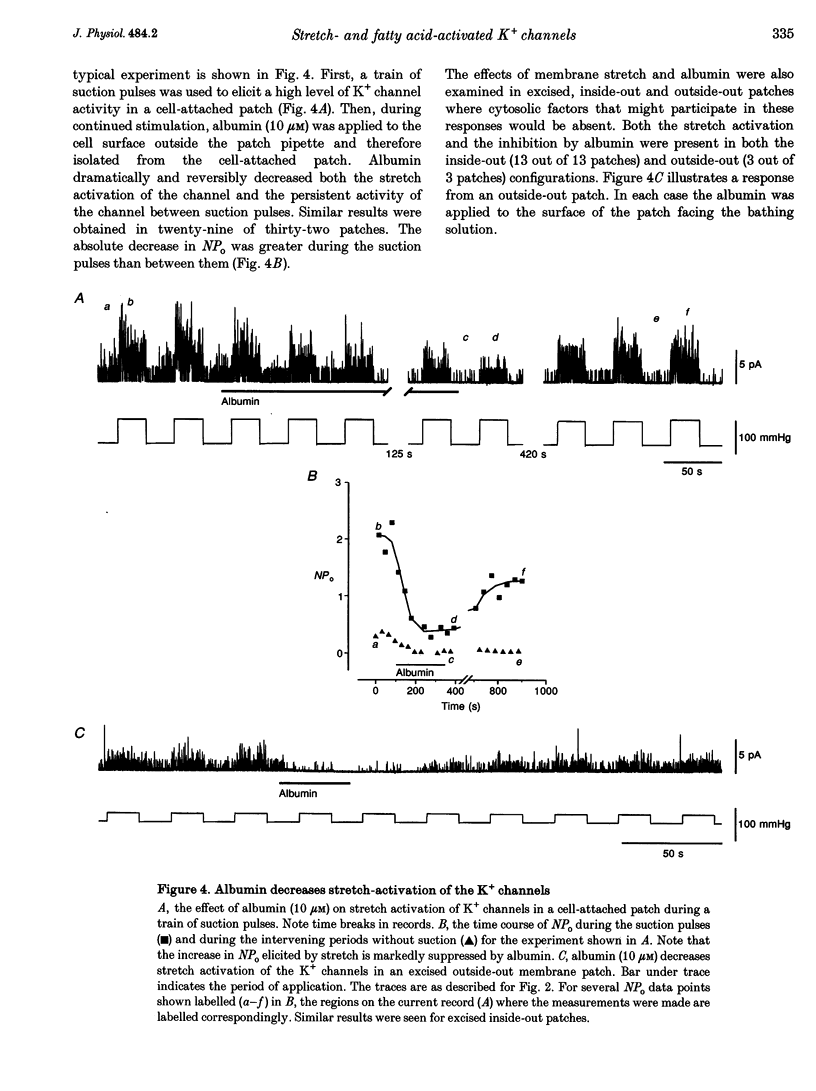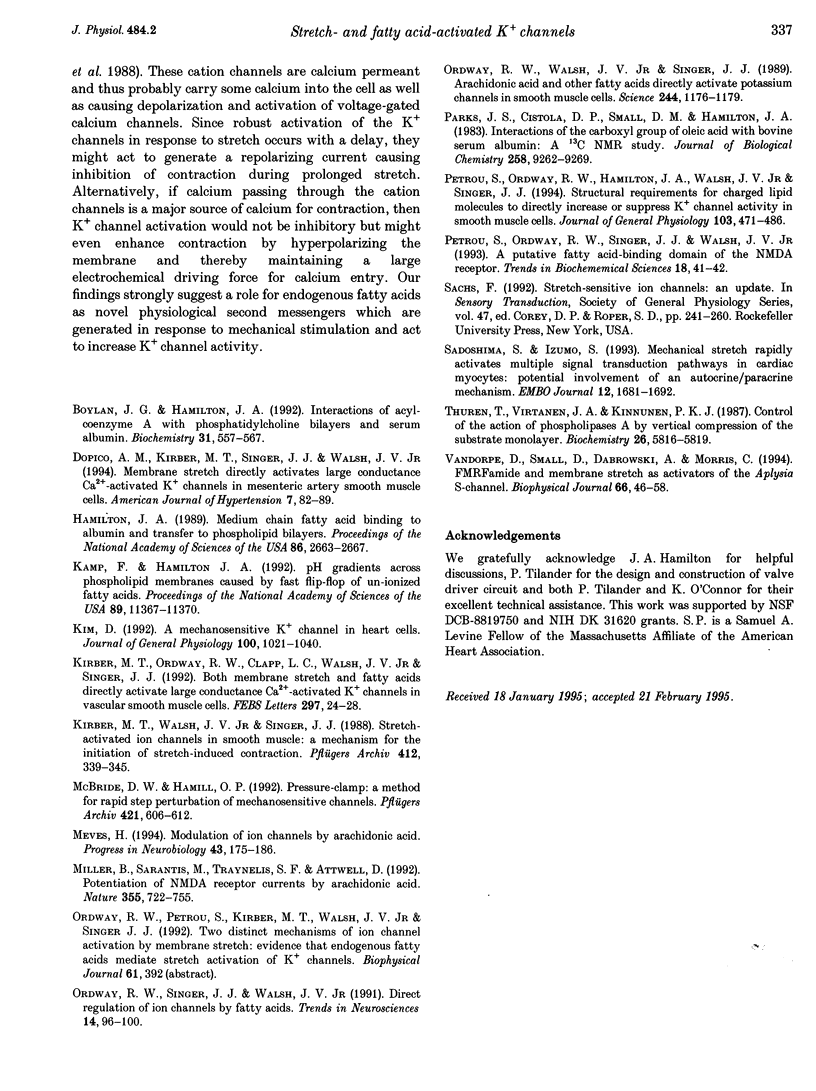Abstract
1. using standard single channel patch clamp techniques we studied the stretch sensitivity of a 20 pS K(+)-selective channel which is activated by fatty acids and found in freshly dissociated smooth muscle cells from the stomach of the toad Bufo marinus. 2. A pulse of suction applied to the back of the patch pipette in order to stretch the membrane resulted in activation of this K+ channel. A train of suction pulses resulted in a gradually increased level of channel activity during each successive pulse, as well as an increase in baseline activity between pulses. This pattern contrasts markedly with many other stretch-activated channels whose activation is limited to the duration of the suction pulse. 3. Application of fatty acids augmented the response to stretch. In contrast, application of 10 microM defatted albumin, which removes fatty acids from membranes, rapidly and reversibly decreased the response to stretch. 4. These results are consistent with the hypothesis that fatty acids which are generated by mechanical stimuli, perhaps by mechanically activated phospholipases, are the intermediaries in activation of certain mechanically sensitive ion channels.
Full text
PDF






Selected References
These references are in PubMed. This may not be the complete list of references from this article.
- Boylan J. G., Hamilton J. A. Interactions of acyl-coenzyme A with phosphatidylcholine bilayers and serum albumin. Biochemistry. 1992 Jan 21;31(2):557–567. doi: 10.1021/bi00117a037. [DOI] [PubMed] [Google Scholar]
- Dopico A. M., Kirber M. T., Singer J. J., Walsh J. V., Jr Membrane stretch directly activates large conductance Ca(2+)-activated K+ channels in mesenteric artery smooth muscle cells. Am J Hypertens. 1994 Jan;7(1):82–89. doi: 10.1093/ajh/7.1.82. [DOI] [PubMed] [Google Scholar]
- Hamilton J. A. Medium-chain fatty acid binding to albumin and transfer to phospholipid bilayers. Proc Natl Acad Sci U S A. 1989 Apr;86(8):2663–2667. doi: 10.1073/pnas.86.8.2663. [DOI] [PMC free article] [PubMed] [Google Scholar]
- Kamp F., Hamilton J. A. pH gradients across phospholipid membranes caused by fast flip-flop of un-ionized fatty acids. Proc Natl Acad Sci U S A. 1992 Dec 1;89(23):11367–11370. doi: 10.1073/pnas.89.23.11367. [DOI] [PMC free article] [PubMed] [Google Scholar]
- Kim D. A mechanosensitive K+ channel in heart cells. Activation by arachidonic acid. J Gen Physiol. 1992 Dec;100(6):1021–1040. doi: 10.1085/jgp.100.6.1021. [DOI] [PMC free article] [PubMed] [Google Scholar]
- Kirber M. T., Ordway R. W., Clapp L. H., Walsh J. V., Jr, Singer J. J. Both membrane stretch and fatty acids directly activate large conductance Ca(2+)-activated K+ channels in vascular smooth muscle cells. FEBS Lett. 1992 Feb 3;297(1-2):24–28. doi: 10.1016/0014-5793(92)80319-c. [DOI] [PubMed] [Google Scholar]
- Kirber M. T., Walsh J. V., Jr, Singer J. J. Stretch-activated ion channels in smooth muscle: a mechanism for the initiation of stretch-induced contraction. Pflugers Arch. 1988 Sep;412(4):339–345. doi: 10.1007/BF01907549. [DOI] [PubMed] [Google Scholar]
- McBride D. W., Jr, Hamill O. P. Pressure-clamp: a method for rapid step perturbation of mechanosensitive channels. Pflugers Arch. 1992 Sep;421(6):606–612. doi: 10.1007/BF00375058. [DOI] [PubMed] [Google Scholar]
- Meves H. Modulation of ion channels by arachidonic acid. Prog Neurobiol. 1994 Jun;43(2):175–186. doi: 10.1016/0301-0082(94)90012-4. [DOI] [PubMed] [Google Scholar]
- Miller B., Sarantis M., Traynelis S. F., Attwell D. Potentiation of NMDA receptor currents by arachidonic acid. Nature. 1992 Feb 20;355(6362):722–725. doi: 10.1038/355722a0. [DOI] [PubMed] [Google Scholar]
- Ordway R. W., Singer J. J., Walsh J. V., Jr Direct regulation of ion channels by fatty acids. Trends Neurosci. 1991 Mar;14(3):96–100. doi: 10.1016/0166-2236(91)90069-7. [DOI] [PubMed] [Google Scholar]
- Ordway R. W., Walsh J. V., Jr, Singer J. J. Arachidonic acid and other fatty acids directly activate potassium channels in smooth muscle cells. Science. 1989 Jun 9;244(4909):1176–1179. doi: 10.1126/science.2471269. [DOI] [PubMed] [Google Scholar]
- Parks J. S., Cistola D. P., Small D. M., Hamilton J. A. Interactions of the carboxyl group of oleic acid with bovine serum albumin: a 13C NMR study. J Biol Chem. 1983 Aug 10;258(15):9262–9269. [PubMed] [Google Scholar]
- Petrou S., Ordway R. W., Hamilton J. A., Walsh J. V., Jr, Singer J. J. Structural requirements for charged lipid molecules to directly increase or suppress K+ channel activity in smooth muscle cells. Effects of fatty acids, lysophosphatidate, acyl coenzyme A and sphingosine. J Gen Physiol. 1994 Mar;103(3):471–486. doi: 10.1085/jgp.103.3.471. [DOI] [PMC free article] [PubMed] [Google Scholar]
- Petrou S., Ordway R. W., Singer J. J., Walsh J. V., Jr A putative fatty acid-binding domain of the NMDA receptor. Trends Biochem Sci. 1993 Feb;18(2):41–42. doi: 10.1016/0968-0004(93)90050-w. [DOI] [PubMed] [Google Scholar]
- Sadoshima J., Izumo S. Mechanical stretch rapidly activates multiple signal transduction pathways in cardiac myocytes: potential involvement of an autocrine/paracrine mechanism. EMBO J. 1993 Apr;12(4):1681–1692. doi: 10.1002/j.1460-2075.1993.tb05813.x. [DOI] [PMC free article] [PubMed] [Google Scholar]
- Thuren T., Virtanen J. A., Kinnunen P. K. Control of the action of phospholipases A by "vertical compression" of the substrate monolayer. Biochemistry. 1987 Sep 8;26(18):5816–5819. doi: 10.1021/bi00392a035. [DOI] [PubMed] [Google Scholar]
- Vandorpe D. H., Small D. L., Dabrowski A. R., Morris C. E. FMRFamide and membrane stretch as activators of the Aplysia S-channel. Biophys J. 1994 Jan;66(1):46–58. doi: 10.1016/S0006-3495(94)80749-0. [DOI] [PMC free article] [PubMed] [Google Scholar]


